Overview
Echeveria are some of the most colorful and spectacular succulent plants. The plants generally feature compact rosettes of succulent fleshy, brightly colored leaves.Echeverias belong to the family Crassulaceae, a very large family containing many genera of succulents such as Aeonium, Crassula, Kalanchoe, Sedum or Sempervivum. There are dozens of species, and hundreds of cultivars offering a wide array of colors, sizes or leaf shapes.
Echeveria succulent plants are originally from Mexico and Central America where humidity is low and temperatures rarely get too hot. Soils are always well draining. Their unique appearance and low maintenance needs have made Echeveria widely popular and thus widely featured in succulent gardens, floral arrangements, terrariums, artwork and even wedding cakes.
Many are popularly called hen-and-chicks because of the way new plantlets, or offsets, develop in a cluster around the parent plant. The usually broad fleshy leaves have waxy, velvety, or powdery surfaces and are often iridescent and sometimes red-edged when in bright sunlight. Echeverias are popular with collectors of succulent plants for their compact symmetrical leaf rosettes and for the prominent stalked inflorescence (flower cluster), which usually rises high above the leaves.
Types Of Echeveria And Their Characteristics
There are about 100 species of Echeveria that come in a variety of colors (we’re talking blue, purple, silver, green, pink, red), so it’s basically guaranteed to match any vibe. Many Echeverias offset readily, eventually forming attractive colonies of rosettes. This suckering habit makes them particularly ornamental in pots that they will fill in no time, often attractively spilling over the edges. Here are the most common types of Echeveria plants:
1. Deranosa Echeveria
Deranosa Echeveria is a rosette-forming succulent featuring grey to bluish-green leaves, with the leaf ends tipped with maroon on the margins. In the spring, it displays bright yellow flowers on tall, pale yellow stalks. This plant is tolerant and easy to care for, especially in containers.

Plant Profile
- Common Name: Deranosa Echeveria
- Plant Type: Cactus/Succulent
- Life Cycle: Perennial
- Light Requirement: Full sun, Filtered/Partial shade
- Soil Preference: Moist, well-drained
- Soil PH: Moderately acidic, Neutral, slightly alkaline
- Mature Height: 5 inches
- Foliage Color: Gray-green
- Bloom Time: Spring
- Flower Color: Yellow
- Propagation: Cuttings, Leaves and offsets
2. Black Prince Echeveria
Echeveria ‘Black prince’ is a hybrid of two plants, that is, Echeveria Shaviana and Echeveria affins. This beautiful Echeveria has gorgeous dark green, purplish and almost black leaves. With keen inspection, you will notice a tinge of yellowish green in the center of the rosette which spreads outward to the tips of the leaves. It produces dark red flowers which provide a striking contrast to its dark foliage. Echeveria ‘Black Prince’ can be grown both indoors and outdoors as long as the right conditions are met.
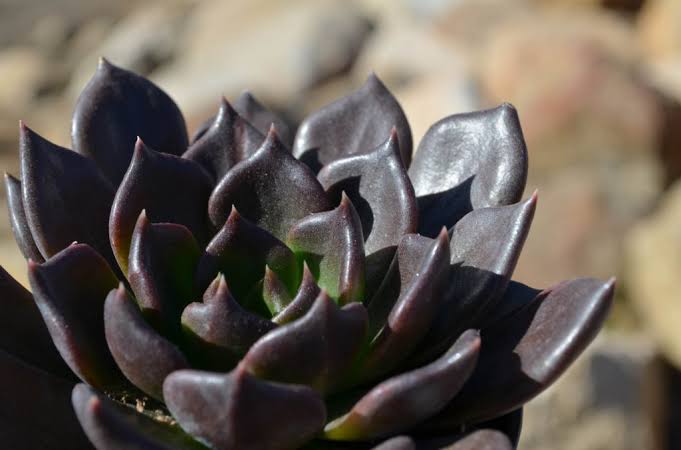
Plant Profile
- Common Name: Echeveria ‘Black prince’
- Plant Type: Cactus/Succulent
- Life Cycle: Perennial
- Light Requirement: Full sun, Filtered/Partial shade
- Soil Preference: Moist, well-drained
- Soil PH: Moderately acidic, Neutral, slightly alkaline
- Mature Height: 6 inches
- Foliage Color: Dark green, purplish and almost black leaves.
- Bloom Time: Spring
- Flower Color: Dark red
- Propagation: Cuttings, Leaves and offsets
- Toxicity: Generally non-toxic to humans
Also Read: Different Types of Euphorbia Varieties
3. Echeveria Affinis (Black Echeveria)
Echeveria affins also commonly referred to as Black Echeveria is a low-growing succulent that forms rosettes of fleshy, brownish-olive leaves. The rosettes grow up to 6 inches tall and about 4 inches in diameter. Leaves are yellowish-green at the base, up to 2 inches long and up to 0.8 inches wide. Flowers are red, star-shaped and sprout on stem during the summer.
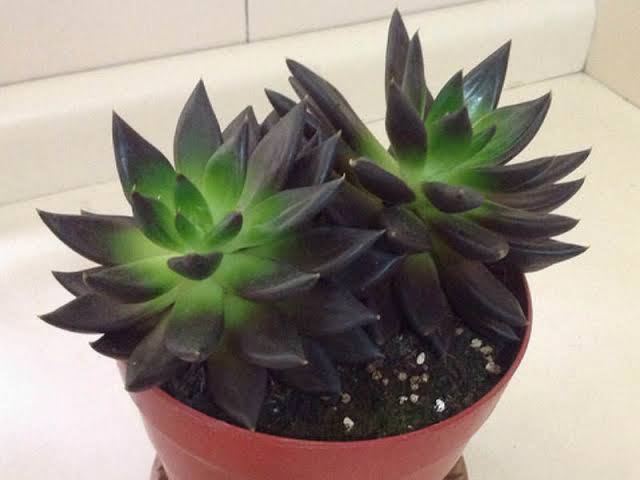
Plant Profile
- Common Name: Echeveria ‘Black prince’
- Scientific Name: Echeveria affins E. Walther
- Plant Type: Cactus/Succulent
- Life Cycle: Perennial
- Light Requirement: Full sun, Filtered/Partial shade
- Soil Preference: Moist, well-drained
- Soil PH: Moderately acidic, Neutral, slightly alkaline
- Mature Height: 6 inches
- Foliage Color: Yellowish-green
- Bloom Time: Spring
- Flower Color: Red
- Propagation: Cuttings, Leaves and offsets
- Toxicity: Generally non-toxic to humans
- USD Hardiness Zones: 9-11
4. Echeveria agavoides (Lipstick Echeveria)
Echeveria agavoides also referred to as lipstick Echeveria is an attractive succulent, forming rosettes of triangular, fleshy, evergreen leaves in pale green with red margins. In spring and early summer, red lantern-shaped flowers with yellow tips appear on tall stems. It’s perfect for growing in gravel gardens and sunny borders, but is best suited to growing in containers, which you can move indoors in autumn to overwinter.
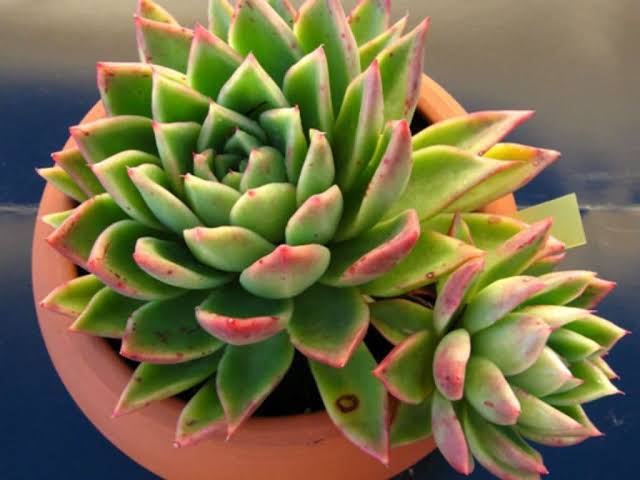
Plant Profile
- Common Name: Echeveria agavoides, lipstick Echeveria, Wax agarve
- Plant Type: Cactus/Succulent
- Life Cycle: Perennial
- Light Requirement: Full sun, Filtered/Partial shade
- Soil Preference: Moist, well-drained
- Soil PH: Moderately acidic, Neutral, slightly alkaline
- Mature Height: 6 inches
- Foliage Color: Yellowish-green
- Bloom Time: Spring
- Flower Color: Red, yellow, green
- Propagation: Cuttings, Leaves and offsets
- Toxicity: Generally non-toxic to humans
- USD Hardiness Zones: 9-11
5. Echeveria colorata (Echeveria lindsayana)
Echeveria colorata also referred to as Echeveria lindsayana is a large clumping succulent that forms mostly a solitary rosette, up to 16 inches in diameter, with distinctive, minty silver-green, upright, arching, lanced-shaped leaves with a fine tips edged in pink/red. While continue growing, it produces many offsets which form a clumping mound. The sweet, pink flowers and arching stems appear in midsummer to fall.

Plant Profile
- Common Name: Echeveria colorata, Echeveria lindsayana
- Plant Type: Cactus/Succulent
- Life Cycle: Perennial
- Light Requirement: Full sun, Filtered/Partial shade
- Soil Preference: Moist, well-drained
- Soil PH: Moderately acidic, Neutral, slightly alkaline
- Mature Height: 6-8 inches
- Foliage Color: silver-green
- Bloom Time: Spring
- Flower Color: Yellow, pink
- Propagation: Cuttings, Leaves and offsets
- Toxicity: Generally non-toxic to humans
- USD Hardiness Zones: 9-11
Also Read: Different Types of Sansevieria Plant
6. Echeveria elegans (Mexican Snowball)
Echeveria elegans also referred to as the Mexican snow ball or Mexican gem is a popular succulent that forms compact rosettes of fleshy, spoon-shaped and pale-green leaves that are tinted on the margins with pink. It bears long slender pink stalks of pink flowers with yellow tips in winter and spring. When grown outdoors in proper conditions, Echeveria elegans spread and will create a thick carped of rosettes, making this plant a great addition to rock gardens or as groundcover. Echeveria elegans can also be planted in containers and thrive indoors.

Plant Profile
- Common Name: Echeveria elegans, the Mexican snow ball, Mexican gem or white Mexican rose
- Plant Type: Cactus/Succulent
- Life Cycle: Perennial
- Light Requirement: Full sun, Filtered/Partial shade
- Soil Preference: Moist, well-drained
- Soil PH: Moderately acidic, Neutral, slightly alkaline
- Mature Height: 6-8 inches
- Foliage Color: pale-green
- Bloom Time: Spring ad Winter
- Flower Color: Pink
- Propagation: Leaves and offsets
- Toxicity: Generally non-toxic to humans
- USD Hardiness Zones: 10-11
7. Echeveria haagai ‘Tolimanensis’
Echeveria tolimanensis is an interesting type of succulent with dark blue, curved, thick, almost cylindrical and fleshy leaves. It has a shrub shape with lots of stem rather than a single rosette. Its leaves are long and tend to drop easily. These leaves still feature farina, a powdery, waxy substance that coats the leaves of many Echeverias. This variety grows a tall bloom stalk each summer from which hang numerous coral red, bell-shaped flowers. It has a high success rate for propagation from offsets, leaves and stem cuttings.

Plant Profile
- Common Name: Echeveria tolimanensis
- Plant Type: Cactus/Succulent
- Life Cycle: Perennial
- Light Requirement: Full sun, Filtered/Partial shade
- Soil Preference: Moist, well-drained
- Soil PH: Moderately acidic, Neutral, slightly alkaline
- Mature Height: 6-8 inches
- Foliage Color: Blue-green
- Bloom Time: Spring ad Winter
- Flower Color: Red-orange, bright yellow
- Propagation: Leaves, cuttings and offsets
- Toxicity: Generally non-toxic to humans
- USD Hardiness Zones: 10-11
8. Echeveria lilacina (Ghost Echeveria)
Echeveria lilacina also referred to as Ghost Echeveria or Mexican hens and chickens, is an attractive slow-growing Echeveria between 6-8 inches tall. The leaves are fleshy, spoon-shaped, silvery-grey and arranged in symmetrical rosette. The flowers are pale pink or coral-pink. They emerge on short, arching racemes on the top of reddish stems. The flowering period is from late winter to early spring.

Plant Profile
- Common Name: Echeveria lilacina, Ghost Echeveria or Mexican hens and chickens
- Plant Type: Cactus/Succulent
- Life Cycle: Perennial
- Light Requirement: Full sun, Filtered/Partial shade
- Soil Preference: Moist, well-drained
- Soil PH: Moderately acidic, Neutral, slightly alkaline
- Mature Height: 6-8 inches
- Foliage Color: Silvery-grey
- Bloom Time: Spring ad Winter
- Flower Color: coral-pink, pale pink
- Propagation: Leaves, cuttings and offsets
- Toxicity: Generally non-toxic to humans
- USD Hardiness Zones: 10-11
9. Echeveria nodulosa (Painted Echeveria)
Echeveria nodulosa commonly referred to as Painted Echeveria is an eye-catching succulent with erect, multi-branched stems that bear rosettes of fleshy, pointed, concave, olive green leaves adorned with vivid red markings on both margins and mid leaf. In summer, tall flowering spikes emerges above the rosettes. The flowers are bell-shaped, rose-red, and yellowish along the margins and tips of petals. Echeveria nodulosa forms a central rosette of foliage surrounded by many offsets and is a great choice for sunny gardens or containers. The markings on its leaves are brought out strongly by direct sunlight.

Plant Profile
- Common Name: Echeveria nodulosa, Pinted Echeveria
- Plant Type: Cactus/Succulent
- Life Cycle: Perennial
- Light Requirement: Full sun, Filtered/Partial shade
- Soil Preference: Moist, well-drained
- Soil PH: Moderately acidic, Neutral, slightly alkaline
- Mature Height: 4-6 inches
- Foliage Color: Olive-green/apple-green
- Bloom Time: Spring ad Winter
- Flower Color: Rose-red
- Propagation: Leaves, cuttings and offsets
- Toxicity: Generally non-toxic to humans
- USD Hardiness Zones: 9-11
- Use: Patio and containers
Also Read: Difference Between Cacti And Agave
10. Echeveria peacockii (Echeveria desmetiana)
Echeveria peacockii, also referred to as Echeveria desmetiana is a fast-growing succulent packed with over 20 spoon-shaped, pointed, pale powdery blue-gray leaves adorned with red edges and tips when exposed to bright light. In summer, it sends up tall stems which bear lantern-shaped, coral to pinkish flowers. This Echeveria offsets readily and will form a dense carpet of rose-like rosettes over time. It is a great choice as groundcover, for rock gardens, green roofs or containers.

Plant Profile
- Common Name: Echeveria peacokii, Echeveria desmetiana
- Plant Type: Cactus/Succulent
- Life Cycle: Perennial
- Light Requirement: Full sun, Filtered/Partial shade
- Soil Preference: Moist, well-drained
- Soil PH: Moderately acidic, Neutral, slightly alkaline
- Mature Height: 3-6 inches
- Foliage Color: Blue-gray
- Bloom Time: Spring, Summer
- Flower Color: Coral to Pinkish
- Propagation: Leaves, cuttings and offsets
- Toxicity: Generally non-toxic to humans
- USD Hardiness Zones: 9-11
- Use: Patio and containers
11. Echeveria pulvinata
Echeveria pulvinata is a gorgeous shrubby succulent that grows up to 12 inches tall and spreads several feet wide. This succulent has stems that are tipped with small rosettes of bright green leaves with pink to red edges. Each leaf is covered in tiny silvery white hairs that help protect it from water loss. In late winter extending to late spring, tall inflorescence appear arching, holding racemes of yellow and orange, bell-shaped flowers.

Plant Profile
- Common Name: Echeveria pulvinata ‘Ruby’
- Plant Type: Cactus/Succulent
- Life Cycle: Perennial
- Light Requirement: Full sun, Filtered/Partial shade
- Soil Preference: Moist, well-drained
- Soil PH: Moderately acidic, Neutral, slightly alkaline
- Mature Height: 6-12 inches
- Foliage Color: Bright-green
- Bloom Time: Spring, Summer
- Flower Color: Yellow/Orange
- Propagation: Leaves, cuttings and offsets
- Toxicity: Generally non-toxic to humans
- USD Hardiness Zones: 9-11
- Use: Patio and containers
12. Echeveria purpusorum (Urbinia purpusii)
Echeveria purpusorum also referred to as Urbania purpusii is a small, slow-growing succulent with tight, usually solitary rosettes that often produce few offsets. Flowers are scarlet red with yellow tips and appear in late spring on a 6-12 inches long stem. The leaves of this succulent is ovate or triangular-ovate, sharp-edged with deep olive-green, grey-green, or white-green and mottled with small, irregular reddish-brown spots.
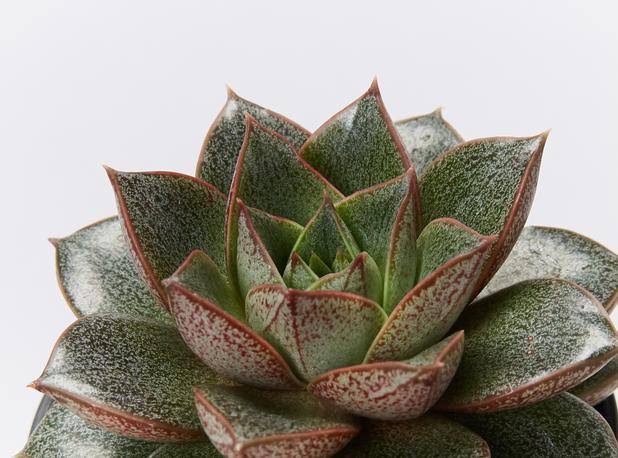
Plant Profile
- Common Name: Echeveria purpusorum
- Scientific Name: Urbinia purpusii
- Plant Type: Cactus/Succulent
- Life Cycle: Perennial
- Light Requirement: Full sun, Filtered/Partial shade
- Soil Preference: Moist, well-drained
- Soil PH: Moderately acidic, Neutral, slightly alkaline
- Mature Height: 3-4 inches
- Foliage Color: Olive-green, grey-green, white-green
- Bloom Time: Spring, Summer
- Flower Color: scarlet red
- Propagation: Leaves, cuttings and offsets
- Toxicity: Generally non-toxic to humans
- USD Hardiness Zones: 9-11
- Use: Patio and containers
Also Read: How to grow and care for Christmas Cactus
13. Echeveria secunda (Glaucous Echeveria)
Echeveria secunda also referred to as Glaucous Echeveria, is a variety that forms attractive clumps less than 6 inches tall of small, tight rosettes of short pale blue-gray leaves with edges and tips adorned with a hint of pink, red or brown. In late spring flowers appear on one foot tall arching stems, the flowers have red calyces and yellow petals, giving them a bi-colored appearance.
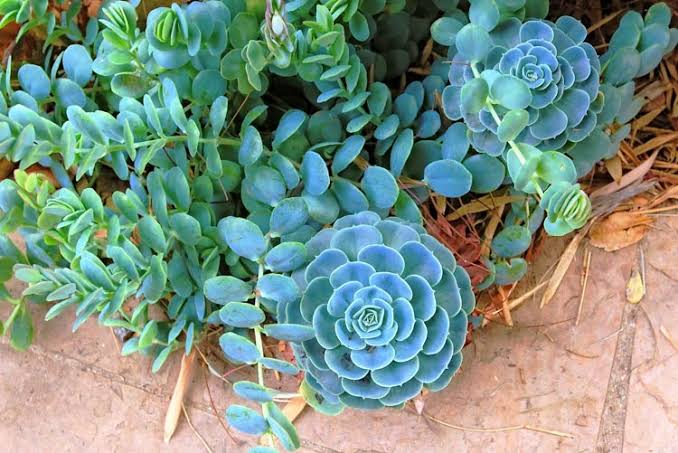
Plant Profile
- Common Name: Echeveria secunda, Glaucous Echeveria
- Plant Type: Cactus/Succulent
- Life Cycle: Perennial
- Light Requirement: Full sun, Filtered/Partial shade
- Soil Preference: Moist, well-drained
- Soil PH: Moderately acidic, Neutral, slightly alkaline
- Mature Height: 4-6 inches
- Foliage Color: Pale bluish-green
- Bloom Time: Spring, Summer
- Flower Color: Red-yellow
- Propagation: Leaves, cuttings and offsets
- Toxicity: Generally non-toxic to humans
- USD Hardiness Zones: 9-11
- Use: Patio and containers
14. Echeveria setosa (Mexican Fire Cracker)
Echeveria setosa also referred to as Mexican fire cracker is an evergreen succulent with short branching stems and rosettes of spoon-shaped green leaves covered with dense white hairs. The rosettes grow up to 5 inches in diameter. Flowers are urn-shaped, orange-red with yellow tips and are borne in one-sided racemes from late spring to summer.

Plant Profile
- Common Name: Echeveria setosa, Mexican fire cracker
- Plant Type: Cactus/Succulent
- Life Cycle: Perennial
- Light Requirement: Full sun, Filtered/Partial shade
- Soil Preference: Moist, well-drained
- Soil PH: Moderately acidic, Neutral, slightly alkaline
- Mature Height: 3-5 inches
- Foliage Color: Green
- Bloom Time: Spring, Summer
- Flower Color: Orange-Red with yellow tips
- Propagation: Leaves, cuttings and offsets
- Toxicity: Generally non-toxic to humans
- USD Hardiness Zones: 9-11
- Use: Patio and containers
Also Read: Different Types of Succulents For Your Home Garden
15. Echeveria shaviana (Echeveria ‘Cheyenne’
Echveria shaviana also referred to as Echeveria ‘Cheyenne’ is a beautiful succulent that forms rosettes of grayish-green to blue-gray leaves with whitish, wavy and crinkled margins that take on a pinkish tint if grown in bright light. The short stemmed rosettes grow up to 8 inches in diameter and produce offsets which form clumping mounds. Leaves take on a pink shade in full sun. Flowers appear in summer on branched, long stems and are bell-shaped, pink with yellow centers.

Plant Profile
- Common Name: Echeveria Cheyenne or Echeveria shaviana
- Plant Type: Cactus/Succulent
- Life Cycle: Perennial
- Light Requirement: Full sun, Filtered/Partial shade
- Soil Preference: Moist, well-drained
- Soil PH: Moderately acidic, Neutral, slightly alkaline
- Mature Height: 4-6 inches
- Foliage Color: Blue-gray, grayish-green
- Bloom Time: Spring, Summer
- Flower Color: Pink with yellow centers
- Propagation: Leaves, cuttings and offsets
- Toxicity: Generally non-toxic to humans
- USD Hardiness Zones: 9-11
- Use: Patio and containers
16. Lola Echeveria
Echeveria Lola is a hybrid between Echeveria lilacina and Echeveria derenbergii. This variety is a unique ‘’rosebud’’ shaped succulent with green leaves featuring a hint of lavender, pink and even light blue, enhanced by a thick layer of almost pearlescent farina, which makes the plant to appear as covered in translucent wax. Its leaves grow in the shape of a rosette, with overlapping leaves that appear to grow out of a heart. During the spring, bell-shaped blooms appear on stalks of about 3 inches. The blooms are in bright shade of pink and yellow.
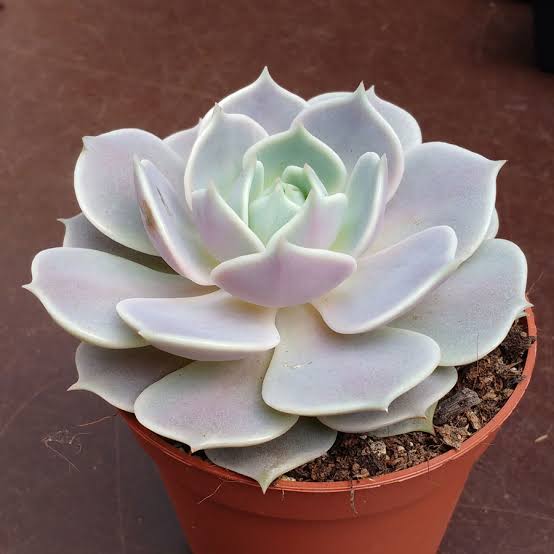
Plant Profile
- Common Name: Echeveria Lola
- Plant Type: Cactus/Succulent
- Life Cycle: Perennial
- Light Requirement: Full sun, Filtered/Partial shade
- Soil Preference: Moist, well-drained
- Soil PH: Moderately acidic, Neutral, slightly alkaline
- Mature Height: 3-6 inches
- Foliage Color: Pale-green, Gray-green
- Bloom Time: Spring, Summer
- Flower Color: Pinkish-yellow
- Propagation: Leaves, cuttings and offsets
- Toxicity: Generally non-toxic to humans
- USD Hardiness Zones: 9-11
- Use: Patio and containers
17. Perle Von Nurnberg Echeveria
Perle Von Nurnberg Echeveria is a hybrid cross between Echeveria gibbiflora and Echeveria elegans. It bears rosettes of pale, blue-green foliage with pink mottling. Its leaves have an elegant curve to them and a coating of farina, gives them a soft sheen. Young leaves growing towards the center of the rosette, have a more intense pink coloration. In summer, coral pink flowers appear on long, red-stems. Perle von Nurnberg can grow to about 6 inches wide if given plenty of sunlight and great drainage.
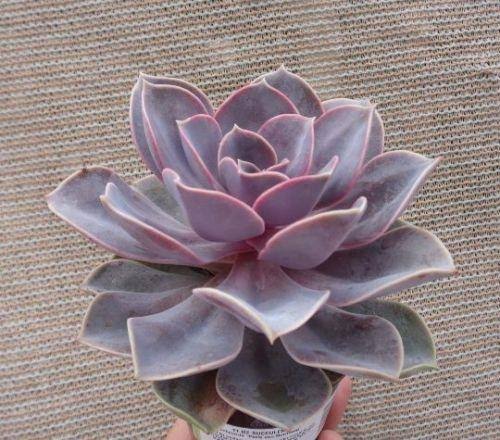
Plant Profile
- Common Name: Perle Von Nurnberg Echeveria
- Plant Type: Cactus/Succulent
- Life Cycle: Perennial
- Light Requirement: Full sun, Filtered/Partial shade
- Soil Preference: Moist, well-drained
- Soil PH: Moderately acidic, Neutral, slightly alkaline
- Mature Height: 4-6 inches
- Foliage Color: Blue-green
- Bloom Time: Spring, Summer
- Flower Color: Coral pink
- Propagation: Leaves, cuttings and offsets
- Toxicity: Generally non-toxic to humans
- USD Hardiness Zones: 9-11
- Use: Patio and containers
18. ‘Blue Prince’ Echeveria
‘Blue prince’ Echeveria variety grow in flower-like rosette shapes, it features blue-green foliage which darkens to bronze as leaves mature. Contrasting yellow flowers appear on tall stems from late spring. Blue prince Echeveria is mainly flowers in summer, but they are mostly grown for their foliage.

Plant Profile
- Common Name: ‘Blue prince’ Echeveria
- Plant Type: Cactus/Succulent
- Life Cycle: Perennial
- Light Requirement: Full sun, Filtered/Partial shade
- Soil Preference: Moist, well-drained
- Soil PH: Moderately acidic, Neutral, slightly alkaline
- Mature Height: 4-6 inches
- Foliage Color: Blue-grey
- Bloom Time: Spring, Summer
- Flower Color: Coral pink
- Propagation: Leaves, cuttings and offsets
- Toxicity: Generally non-toxic to humans
- USD Hardiness Zones: 9-11
- Use: Patio and containers
Also Read: Different Types of Haworthia Succulents
19. Echeveria runyonii ‘Topsy Turvy’
Echeveria runyonii ‘Topsy Turvy’ is an evergreen succulent with stemless rosettes of waxy, spoon-shaped, powdery blue-grey leaves which are amazingly rolled downwards along their length and curled up so that the tips point towards the center of the plant. In late summer or fall, it sends up tall arching stems which bear star-shaped, yellow and orange flowers. Echeveria runyonii ‘Topsy Turvy’ offsets readily and will form a dense carpet of rosettes over a given period of time.

Plant Profile
- Common Name: Echeveria runyonii ‘Topsy Turvy’
- Plant Type: Cactus/Succulent
- Life Cycle: Perennial
- Light Requirement: Full sun, Filtered/Partial shade
- Soil Preference: Moist, well-drained
- Soil PH: Moderately acidic, Neutral, slightly alkaline
- Mature Height: 3-6 inches
- Foliage Color: Blue-grey
- Bloom Time: Spring, Summer
- Flower Color: Yellow
- Propagation: Leaves, cuttings and offsets
- Toxicity: Generally non-toxic to humans
- USD Hardiness Zones: 9-11
- Use: Patio and containers
20. Echeveria ‘Doris Taylor’ (Wooly Rose)
Echeveria ‘Doris Taylor’ also referred to as Wooly Rose is a gorgeous succulent that forms charming rosettes of pale-green, fleshy leaves reaching 7 to 8 inches. The leaf tips of this Echeveria are sometimes dark whereas the whole plant including flowers is coated with a thick layer of white-hairs. Its stems are short with numerous horizontal offsets. Flowers are yellow inside, red shading to yellow outside and appear in spring to fall.

Plant Profile
- Common Name: Echeveria ‘Doris Taylor’
- Plant Type: Cactus/Succulent
- Life Cycle: Perennial
- Light Requirement: Full sun, Filtered/Partial shade
- Soil Preference: Moist, well-drained
- Soil PH: Moderately acidic, Neutral, slightly alkaline
- Mature Height: 5-8 inches
- Foliage Color: Pale-green
- Bloom Time: Spring, Summer
- Flower Color: Yellow
- Propagation: Leaves, cuttings and offsets
- Toxicity: Generally non-toxic to humans
- USD Hardiness Zones: 9-11
- Use: Patio and containers